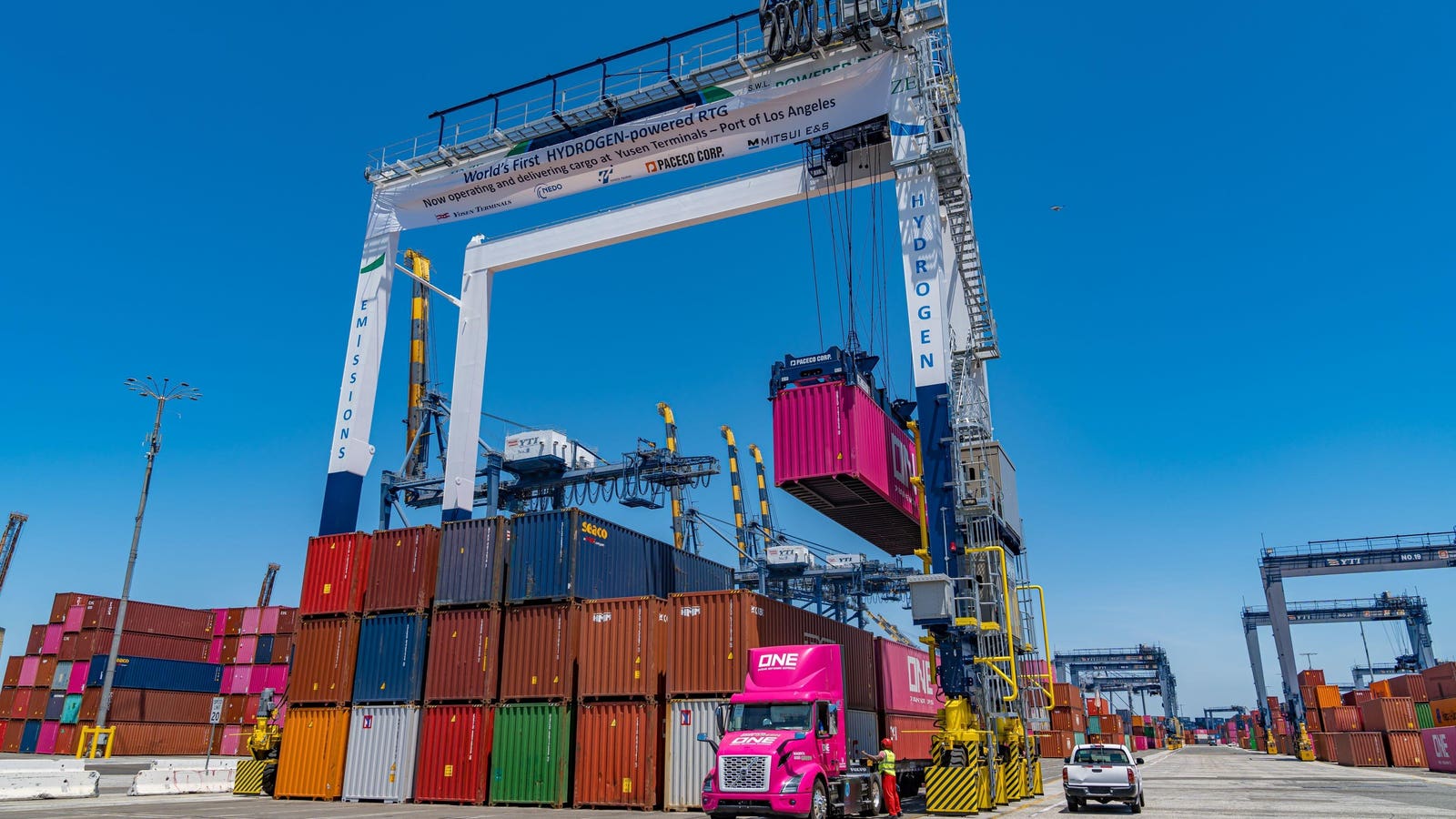PACECO Corp. recently began commercial operation of the world’s first hydrogen fuel cell-powered rubber-tired gantry (RTG) crane at the Port of Los Angeles. Founded in 1958, PACECO Corp. is a leading supplier in the container handling sector, headquartered in Hayward, California. Over the years, the company has delivered more than 2,500 container handling systems to more than 200 ports around the world. The Port of Los Angeles will be one of the key hubs in the ARCHESH2 project, known as the California Hydrogen Hub, recently designated by the Department of Energy. The California Hydrogen Hub is set to receive significant funding from the Department of Energy, up to $1.2 billion, bringing the total investment in hydrogen technology to up to $15 billion. Pioneering projects like PACECO’s hydrogen-powered cranes point to exciting developments ahead for the Port of Los Angeles to decarbonize and reduce pollution throughout the region.
Unlike its rail-based siblings, which can only move in one row, RTG A-frame cranes can move flexibly within a terminal and accommodate containers stacked in multiple rows. They can move containers from one port to another or load them onto vehicles. Developed in collaboration with Mitsui E&S and funded by Japan’s New Energy and Industrial Technology Development Organization (NEDO), the H2-ZE RTG Transtainer Crane began operation at Yusen Terminal Co., Ltd. (YTI) on May 7, 2024. This marks the world’s first commercially operational instance of a fully hydrogen-powered RTG crane.
“YTI is proud to host this groundbreaking demonstration project for PACECO,” said Alan McCorkle, president and CEO of Yusen Terminals. “Having the H2-ZE RTG Transtainer crane operational at our terminal is an important step toward a zero-emission terminal. This crane will help the Port of Los Angeles achieve its ambitious sustainability goals.”
The H2-ZE RTG Transtainer crane has been revolutionized with the introduction of fuel cell hydrogen technology. It marks the latest advancement in crane power plant design as part of a phased approach towards achieving zero emissions. Initially, the crane relied on a 500kW diesel generator, which emitted the carbon dioxide equivalent of burning over 400 barrels of oil per year. The generator powered electric wheels, much like diesel locomotives and large mining vehicles. Over time, PACECO gradually hybridized the crane’s power plant by incorporating a 100kW diesel engine supported by a larger battery and integrated electronics. But the latest design takes emissions reduction to the next level. PACECO and Mitsui E&S developed a custom-built fuel cell power pack unit that replaces the diesel components of the already electrified system. This fuel cell power pack unit, supplied by Toyota, shares fuel cell and hydrogen tank components with the Mirai fuel cell passenger vehicle. In the future, integration of US-based components may also be possible.
The innovative system boasts a continuous power output of 60kW, a storage capacity of 32kg at 700 bar pressure and can operate for up to 16 hours. With this advanced technology in place, the crane achieves absolute zero emissions, setting a new standard in environmentally friendly operations. In addition to eliminating emissions, hydrogen allows for long-term operation, making it suitable for typical two-shift terminal operations. Alternative options such as relying solely on batteries or using a power cable were not considered feasible given the duty cycle and logistics of implementation.
Refueling takes place once a day during the third non-working shift between 3 am and 7 am. Toyota Tsusho and OneH2 have built a mobile refueling unit, a multi-tank trailer, with a maximum pressure of 930 bar. It employs a cascade system that switches between tanks with a maximum flow rate of 2 kg/min, and the entire refueling takes approximately 30 minutes.
PACECO’s pioneering demonstration marks an important step in the global maritime logistics industry’s sustainability efforts. Scheduled to operate for the next four years at the Yusen Terminal in the Port of Los Angeles, this cutting-edge project reinforces PACECO’s commitment to global efforts to reduce port emissions through the deployment of zero-emission hydrogen technology. The company is eager to expand the deployment of its fuel cell power pack concept and is pursuing future deployment opportunities.
“With the entry into service of the H2-ZE RTG Transtainer crane, we are not only introducing a new fuel technology for cranes, but also leading the way for the industry to significantly reduce emissions,” said Troy Collard, general manager of sales for PACECO. “We are pleased to have this crane operational here in Los Angeles and thank all of our pilot partners for their support throughout this entire process.”
Check out my website and other work here.
Source link

